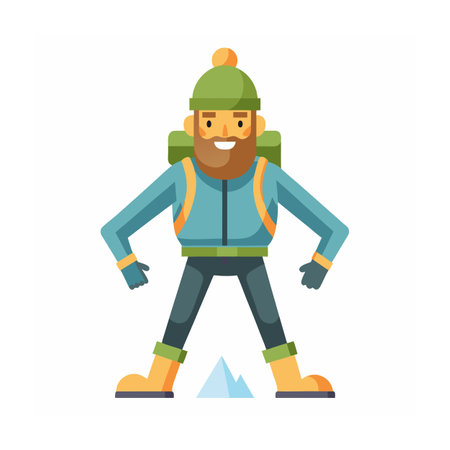1. Understanding Seasonal Shifts Across U.S. National Parks
The United States boasts a stunning variety of national parks, each with its own unique climate and character. From the icy summits of Yellowstone, where winter can linger well into spring, to the subtropical warmth of Florida’s Everglades, where humidity shapes every adventure, these parks offer a dynamic spectrum of weather conditions throughout the year. Recognizing how these seasonal changes affect your park experience is essential for planning and packing appropriately. In the Rockies, snowstorms can roll in unexpectedly even during summer months, while in the Southwest, daytime temperatures swing dramatically from sun-baked afternoons to chilly desert nights. Meanwhile, Pacific Northwest parks like Olympic see relentless rainfall and shifting fog, and Appalachian gems such as Great Smoky Mountains display vibrant foliage but also unpredictable downpours. Understanding these patterns not only prepares you for comfort but also enhances safety and enjoyment—each layer you choose becomes a response to nature’s rhythm, tailored to the region and time of year you visit.
2. Foundations of Effective Layering
When planning an adventure in U.S. National Parks, understanding the fundamentals of layering is a game-changer for both comfort and safety. The weather across America’s national parks can shift quickly—sunshine at trailhead, drizzle or snow at higher elevations, crisp mornings that morph into warm afternoons. That’s why having a versatile layering system isn’t just a pro tip; it’s essential gear strategy.
The Three-Layer System Explained
Layering is all about combining three main types of clothing: base layer, insulation layer, and outer layer. Each plays a unique role in keeping you dry, warm, and protected from the elements. Here’s how they work together:
| Layer | Main Function | Best Materials | U.S. Park Examples |
|---|---|---|---|
| Base Layer | Wicks moisture away from skin | Merino wool, synthetic fibers | Zion (hot hikes), Glacier (chilly mornings) |
| Insulation Layer | Traps body heat | Fleece, down, synthetic fill | Yosemite (cool evenings), Acadia (shoulder seasons) |
| Outer Layer | Shields against wind & precipitation | Waterproof/breathable shell, softshell | Olympic (rainforest zones), Rocky Mountain (sudden storms) |
Why Layering Matters in the Wild
The right combination keeps you from overheating or getting chilled as weather changes—a common scenario in places like Grand Canyon or Mount Rainier. Getting wet from sweat or rain without proper layers can quickly lead to discomfort or even hypothermia. Being able to add or shed layers on the fly means you stay comfortable and safe no matter what nature throws your way.
Practical Takeaway:
A solid layering approach lets you adapt fast: peel off insulation when the sun comes out, throw on your shell when clouds roll in. This adaptability is what makes layering not just a skill but essential outdoor know-how for every U.S. National Park explorer.

3. Spring and Summer Essentials: Staying Cool and Dry
As the snow melts and wildflowers start to bloom, U.S. National Parks transform into vibrant playgrounds for hikers, campers, and outdoor enthusiasts. But with rising temperatures, unpredictable rain showers, and relentless sunshine, your layering strategy needs a serious seasonal upgrade. Here’s how to tailor your gear for spring and summer adventures while keeping comfort and safety at the forefront.
Choose Lightweight, Moisture-Wicking Fabrics
Spring and summer in the parks can bring sweltering afternoons followed by cool evenings—sometimes all in a single day. Your base layers should be made of technical fabrics like polyester or merino wool that wick sweat away from your skin. Avoid cotton, which holds moisture and leaves you clammy after a sweaty hike or sudden rainstorm. Look for shirts and underwear labeled “moisture-wicking” or “quick-dry”—these are your frontline defense against chafing and heat rash.
Layering for Changing Conditions
The key to comfort is flexibility. Start with a breathable base layer, add a lightweight long-sleeve shirt for extra sun protection or warmth when needed, and keep a packable rain jacket handy for those infamous afternoon showers common in places like Yellowstone or Shenandoah. Even if the forecast looks clear, weather can turn on a dime in mountainous regions.
Smart Sun Protection Tactics
Intense sun exposure is one of the biggest hazards during spring and summer visits to national parks. Opt for clothing with UPF (Ultraviolet Protection Factor) ratings—many outdoor brands now offer shirts, hats, and neck gaiters designed specifically to block harmful rays. Wide-brimmed hats, sunglasses with UV protection, and high-SPF sunscreen (reapplied every two hours) are non-negotiables. Don’t forget lip balm with SPF—sunburned lips are no fun after a long trail day.
Stay Ready for Rain
Packing an ultralight rain shell is essential even on bluebird days. Sudden downpours are part of the American park experience—especially in the Rockies or Appalachians. Stash your jacket in an easily accessible pocket of your backpack so you’re never caught off guard. Consider rain pants if you’ll be hiking longer distances or venturing above treeline where shelter is scarce.
Final Thoughts: Adaptability is Key
Spring and summer layering in U.S. National Parks is all about balancing comfort with preparedness. Prioritize moisture management, sun safety, and quick adaptability to shifting weather conditions so you can focus on soaking up every view without distraction. Remember: the right layers mean more time exploring—and less time worrying about what Mother Nature throws your way.
4. Fall and Winter Strategies: Retaining Warmth and Tackling the Cold
As crisp autumn air sweeps through the U.S. National Parks and winter’s chill settles in, your layering strategy shifts from breathability to focused warmth retention. Whether you’re hiking in Yosemite’s golden forests or braving Yellowstone’s snowy expanses, understanding thermal insulation, cold snap management, and snow-specific adjustments is crucial for safety and comfort.
Thermal Insulation Fundamentals
The secret sauce for thriving in colder months is a smart approach to insulation. Start with a moisture-wicking base layer—synthetic or merino wool—to keep sweat off your skin. Add a middle insulating layer like fleece or down, then top it with a weatherproof shell to block wind, rain, or snow. The chart below breaks down key layering options:
| Layer | Material | Purpose |
|---|---|---|
| Base | Synthetic/Merino Wool | Moisture Management |
| Mid | Fleece/Down/Synthetic Insulation | Heat Retention |
| Outer Shell | Waterproof/Breathable Fabric (e.g., Gore-Tex) | Protection from Elements |
Managing Cold Snaps & Sudden Temperature Drops
National parks can surprise you with rapid weather changes, especially above 6,000 feet. Always pack an extra insulated jacket or vest in your daypack; synthetic fill performs better than down if it gets wet. Be sure to bring a beanie, gloves, and neck gaiter—even if forecasts seem mild—since extremities lose heat fastest.
Essential Considerations for Snow & Ice
- Choose waterproof boots with aggressive tread or add microspikes for icy trails.
- Packing gaiters will keep snow out of your socks during deep snow hikes.
- Chemical hand and toe warmers are lightweight additions that make a big difference on frigid mornings.
Versatile Gear Adjustments for Changing Conditions
Opt for zippered layers and ventilation panels so you can adjust as activity level or sun exposure changes. Modular mittens (shell plus liner) are clutch for swapping warmth on the fly. Always carry backup dry socks and gloves—a small dry bag ensures they stay usable even in heavy snow or sleet.
By fine-tuning your gear selection and layering system for fall and winter’s unique demands, you’ll be ready to experience America’s national parks at their most dramatic—and stay safe while doing it.
5. Pro Tips: Packing Smarter for National Park Adventures
Mastering the art of packing for U.S. national parks is about more than just stuffing a backpack—it’s about knowing what you truly need and making each item count. Here are some culture-savvy strategies to balance pack weight, select multi-purpose gear, and prepare for classic American outdoor activities.
Keep It Light, Keep It Right
Americans love to travel light, especially on the trail. A good rule of thumb: your packed bag should never exceed 20% of your body weight. This means you’ll need to be ruthless—ditch “just in case” extras and focus on essentials that serve more than one purpose.
Choose Versatile Layers
Look for items that can adapt to changing conditions—think zip-off pants that turn into shorts, or a lightweight puffer jacket that works as both an outer layer and a pillow at night. Merino wool tees are a favorite among U.S. hikers because they keep you warm when it’s cold, cool when it’s hot, and don’t hold odors (a must for multi-day trips).
Multi-Use Gear Is Your Best Friend
Packing multipurpose items isn’t just smart—it’s part of the American outdoor ethos. A buff can serve as a neck gaiter, sweatband, or emergency potholder. Collapsible trekking poles double as tent supports if you’re using an ultralight shelter. Even duct tape wrapped around your water bottle can fix gear in a pinch or prevent blisters.
Prepare for Iconic Activities
The most popular national park adventures—like hiking to waterfalls, car camping under the stars, or spotting wildlife at dawn—each have their own packing quirks. For hiking, opt for trail runners over bulky boots unless you expect snow or rough terrain; Americans value comfort and speed on maintained trails. For camping, lightweight stoves and compact cookware keep things simple without sacrificing those beloved campfire meals (don’t forget s’mores supplies!). If wildlife watching is on your list, bring binoculars that won’t weigh you down and a neutral-toned jacket to blend into your surroundings.
Cultural Bonus: Leave No Trace
Packing smarter also means being a good steward of the land—a core value in the U.S. outdoors community. Use reusable containers instead of single-use plastics, and always pack out what you pack in. By embracing these habits, you’ll fit right in with experienced park-goers and help preserve these incredible places for future generations.
6. Embracing Seasonal Transitions: Real-Life Scenarios
Understanding layering in theory is helpful, but seeing how it works in real-life situations can make all the difference when youre gearing up for a national park adventure. Below, youll find scenario-based examples that blend the four-season principles with practical packing lists for iconic U.S. parks and their unique climates.
Spring in Great Smoky Mountains National Park
Early spring here means chilly mornings, potential rain, and mild afternoons. Start with a moisture-wicking base layer, add an insulated mid-layer like a fleece pullover, and top it off with a lightweight waterproof shell. Pack a beanie and gloves—frosty mornings arent uncommon! As temperatures rise, shed your shell and mid-layer for comfortable hiking.
Summer in Yosemite National Park
Yosemite’s summer days are sunny and warm, but evenings can still feel crisp at higher elevations. Opt for a breathable short-sleeve base layer and convertible hiking pants. Keep a light long-sleeve shirt handy for sun protection or cooler temps at dusk. A packable windbreaker is smart for sudden weather changes on exposed trails like Glacier Point.
Fall in Acadia National Park
Maine’s autumns are famous for rapid weather shifts—from misty mornings to breezy afternoons. Layer up with a merino wool tee as your base, followed by a synthetic vest and a flannel shirt. Bring a compact puffer jacket for surprise chills on Cadillac Mountain and don’t forget rain gear—fall showers can roll in quickly from the coast.
Winter in Rocky Mountain National Park
Expect snow, wind, and fluctuating temperatures. Begin with thermal underwear (top and bottom), add a heavyweight fleece or down mid-layer, and finish with a waterproof-breathable shell jacket and pants. Accessories matter: pack insulated gloves, a neck gaiter, and thick wool socks. Always carry extra layers in your pack—mountain weather is notoriously unpredictable.
Layering Takeaways for Every Season
Each national park—and each season—brings its own challenges. The key is flexibility: check the local forecast before you go, build your clothing system around proven layering principles, and bring versatile pieces that mix-and-match easily. This approach not only keeps you safe but also lets you fully embrace the beauty of America’s wild places year-round.


